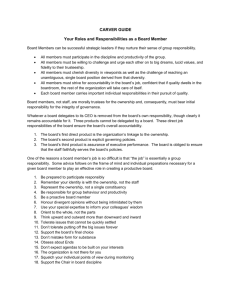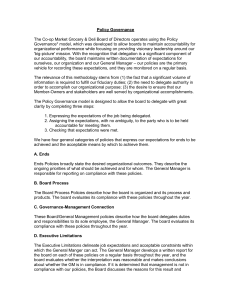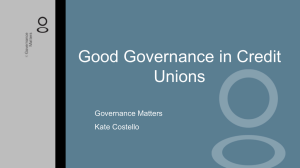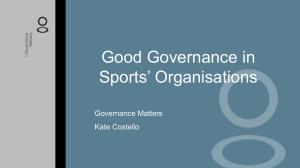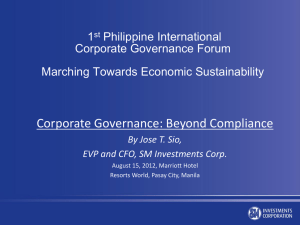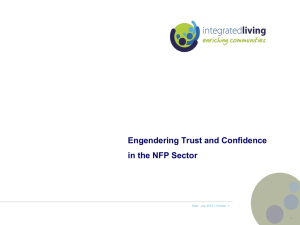Good Governance in Government Entities Powerpoint pp1000027
advertisement
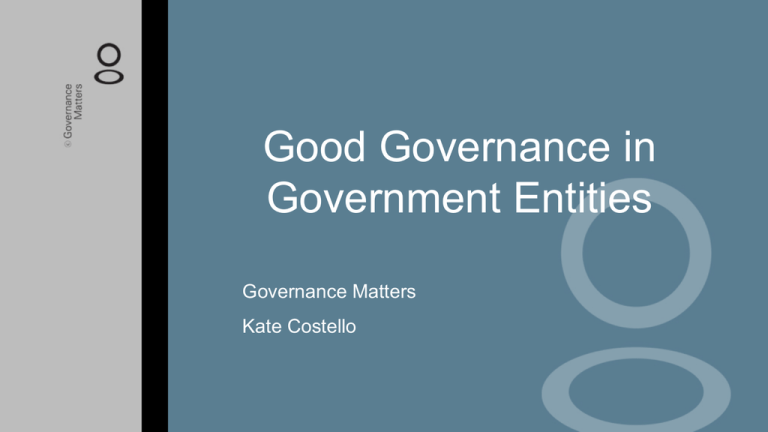
Good Governance in Government Entities Governance Matters Kate Costello Effective Governance • understand the role of the Board • get the right skills and encourage the right behaviour • introduce effective processes Understand the Role of the Board Governance is what the Board does or should do to be a “value-adder” to the organisation rather than just a “costcentre”. It is different from what management does or should do. What is Governance? “The Board’s role is to create the future of the organisation, not just mind the shop”. John Carver The Role of the Board Outward Looking Compliance Roles Inward Looking Strategy Formulation Accountability Appoint CEO Monitoring and Supervision Past & Present Performance Roles Policy Making Future *adapted from Tricker, RI: International Corporate Governance (1994) p149 Accountability Those you can’t say no to! • • • • the law and regulation constituent document or empowering legislation creditors (eg. bank; suppliers) other contractors (eg government funding; sponsors) Accountability Those you need to listen to! • owners (shareholders; members; government) • customers • staff • the community Good Governance in Accountability • “listening” to stakeholders • risk management • organisational culture Strategy Formulation • what is “Strategy”? – Michael Porter • the gut, the head, the heart • answer the hard questions Good Governance in Strategy • longer term strategic plan (with measures) • aligned operational/business/annual plan (with measures) • aligned budgets Good Governance in Strategy • dedicate some board meetings to strategic matters • spend the first hour on a strategic issue • reorganise the agenda (decision; discussion; noting) Policy “I define policy as the value or perspective that underlies action. Of course that means everyone in the organisation makes policy including staff members, but boards must make the broadest and most inclusive policies in order to control the organisation. The trick is for the board to make distinctions between the types and sizes of policy, so that what is delegated is clear”. Carver J: Reinventing Your Board, P41 Good Governance in Policy Carver argues that the board only has one employee, the CEO. “The board will: • instruct only the CEO • view all organisational performance as that of the CEO • view any organisational failure to comply with board policy as the failure of the CEO • require that the CEO keep the organisational performance within policy criteria and restore it to this state should there be policy violations • never in its official capacity, help the CEO manage” John Carver Good Governance in Policy • • • Matters reserved for the board Policy separated from minutes Board Manual Monitoring and Supervision • • • • By strategic KPIs By annual KPIs By compliance with board policy By agreeing what information will come to the board, in what format CEO and Succession • • • • “hire and fire” the CEO remunerate and reward assess performance plan for succession Get the Right Skills • size of the board • board skill set • committees the right ones? clear terms of reference? reviewed, or task forces? • amend constituent document Board Member Knowledge • • induction management update sessions • expert reports • expert development sessions • Board and director performance evaluation Encourage the Right Behaviour Board Effectiveness Research Shey Newitt Compliant but not contributing: why Australian boards are being underutilised Working Relationships • • • Chair – CEO relationship critical behaviour and teamwork a “living” Code of Conduct Introduce Effective Processes • • • • • calendar papers before meeting clear, concise, precise papers duration of meetings calibre of minutes plus action list • receipt of minutes after meeting Effective Governance • understand the role of the Board • get the right skills and encourage the right behaviour • introduce effective processes Good Governance in Government Entities Structure Varies: • department • statutory authority – advisory or decision-making • wholly-owned or partly-owned company Structure • Commonwealth and states have their own classifications • nomenclature may be confusing: • the entity called “the Board” • the entity has a “board” • often two “owners”: portfolio and shareholder ministers Structure • skill mix on board if nominees • Chair/board to influence Minister to create the right skill–mix on the board • conflicts may arise where board members appointed because of expertise from operating in the field Structure • Audit Committee – Auditor-General as auditor • Remuneration Committee – where board sets remuneration of CEO and other senior executives • other committees? Accountability Legislative compliance: • specific purpose legislation • legislation applying to certain types of government entities • legislation applying to all government entities Accountability • prescriptive content and timing of reporting and disclosure obligations • triple bottom line reporting Accountability • relationship with Minister: department CE and Chair • Formal charter (or MOU) clearly setting out role, responsibilities and relationships between department and entity (and its board) • Ministerial direction: in writing; recorded in minutes; referenced in annual report Strategy • tension between financial and social objectives • Chair must agree with Minister the long term objective of the government • Statement of Corporate Intent – may contain high-level policy on, eg. asset acquisition, capital structure, accounting policies Strategy • Corporate Plan: 3 plus years – lots of analysis and information • Business Plan and Budget: 1 year Policy • may be tied to government policy eg. purchasing and tendering • grants for programs will require certain policies and processes • but, entity needs the freedom to develop policies without interference from department or Minister’s staffers In Summary Influence the right skill-mix Define who does what Maintain a relationship with the Minister Your checklist Good Governance in Government En Governance Matters governancematters.com.au
